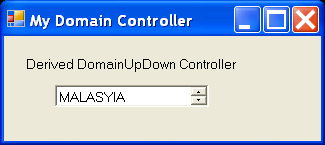UpDown Derived

/*
Professional Windows GUI Programming Using C#
by Jay Glynn, Csaba Torok, Richard Conway, Wahid Choudhury,
Zach Greenvoss, Shripad Kulkarni, Neil Whitlow
Publisher: Peer Information
ISBN: 1861007663
*/
using System;
using System.Drawing;
using System.Collections;
using System.ComponentModel;
using System.Windows.Forms;
using System.Data;
namespace UpDown_Derived
{
/// <summary>
/// Summary description for UpDownDerived.
/// </summary>
public class UpDownDerived : System.Windows.Forms.Form
{
/// <summary>
/// Required designer variable.
/// </summary>
private System.ComponentModel.Container components = null;
private System.Windows.Forms.Label label1;
private MyUpDownControl mDC = null ;
public UpDownDerived()
{
//
// Required for Windows Form Designer support
//
InitializeComponent();
//
// TODO: Add any constructor code after InitializeComponent call
//
}
/// <summary>
/// Clean up any resources being used.
/// </summary>
protected override void Dispose( bool disposing )
{
if( disposing )
{
if (components != null)
{
components.Dispose();
}
}
base.Dispose( disposing );
}
#region Windows Form Designer generated code
/// <summary>
/// Required method for Designer support - do not modify
/// the contents of this method with the code editor.
/// </summary>
private void InitializeComponent()
{
this.mDC = new UpDown_Derived.MyUpDownControl();
this.label1 = new System.Windows.Forms.Label();
this.SuspendLayout();
//
// mDC
//
this.mDC.Items.Add("FRANCE");
this.mDC.Items.Add("ITALY");
this.mDC.Items.Add("USA");
this.mDC.Items.Add("UK");
this.mDC.Items.Add("AUSTRALIA");
this.mDC.Items.Add("INDIA");
this.mDC.Items.Add("ZAMBIA");
this.mDC.Items.Add("MALASYIA");
this.mDC.Location = new System.Drawing.Point(40, 40);
this.mDC.Name = "mDC";
this.mDC.TabIndex = 0;
//
// label1
//
this.label1.Location = new System.Drawing.Point(16, 16);
this.label1.Name = "label1";
this.label1.Size = new System.Drawing.Size(200, 16);
this.label1.TabIndex = 1;
this.label1.Text = "Derived DomainUpDown Controller";
//
// UpDownDerived
//
this.AutoScaleBaseSize = new System.Drawing.Size(5, 13);
this.ClientSize = new System.Drawing.Size(248, 85);
this.Controls.AddRange(new System.Windows.Forms.Control[] {
this.label1,
this.mDC});
this.Name = "UpDownDerived";
this.Text = "My Domain Controller";
this.Load += new System.EventHandler(this.UpDownDerived_Load);
this.ResumeLayout(false);
}
#endregion
/// <summary>
/// The main entry point for the application.
/// </summary>
[STAThread]
static void Main()
{
Application.Run(new UpDownDerived());
}
private void UpDownDerived_Load(object sender, System.EventArgs e)
{
}
}
/// <summary>
/// Summary description for MyUpDownControl.
/// </summary>
public class MyUpDownControl : System.Windows.Forms.DomainUpDown
{
private int currentPos =0;
private string DisplayText ="";
public MyUpDownControl()
{
// Populate the control with items
Items.Add("FRANCE");
Items.Add("ITALY");
Items.Add("USA");
Items.Add("UK");
Items.Add("AUSTRALIA");
Items.Add("INDIA");
Items.Add("ZAMBIA");
Items.Add("MALASYIA");
}
public override void DownButton()
{
// Check if the Down Arrow is clicked
currentPos ++;
if ( currentPos >= Items.Count )
currentPos = 0 ;
UpdateEditText();
}
public override void UpButton()
{
// Check if the Up Arrow is clicked
currentPos -- ;
if ( currentPos < 0 ) currentPos = Items.Count-1 ;
UpdateEditText();
}
protected override void UpdateEditText()
{
// Update the EditBox
DisplayText = (string)this.Items[currentPos ];
this.Text = DisplayText;
}
public void Sort()
{
if ( this.Sorted )
this.Sorted= false ;
else
this.Sorted= true ;
if ( this.Sorted )
this.Sort() ;
UpdateEditText() ;
}
}
}
Related examples in the same category